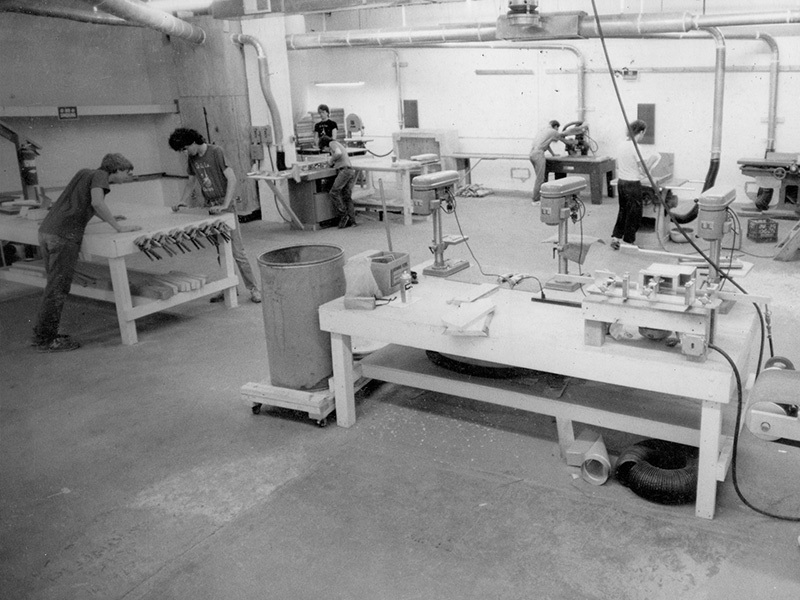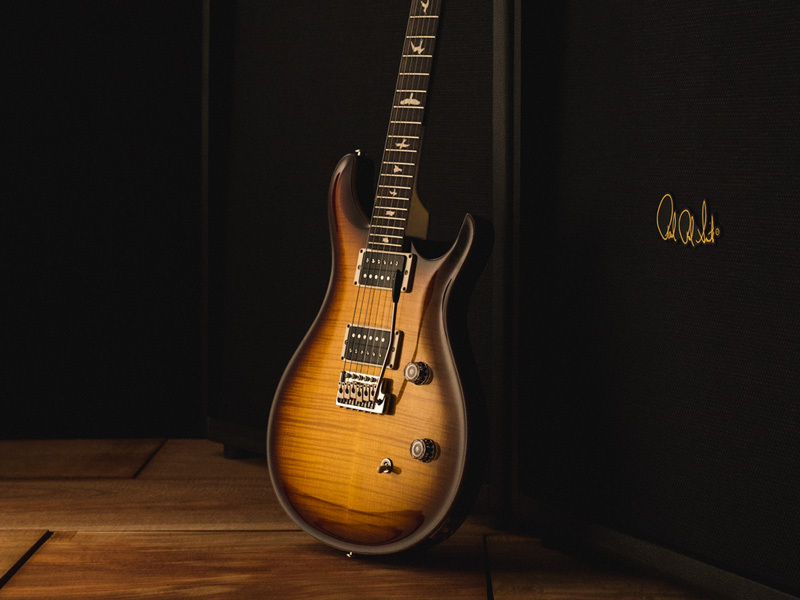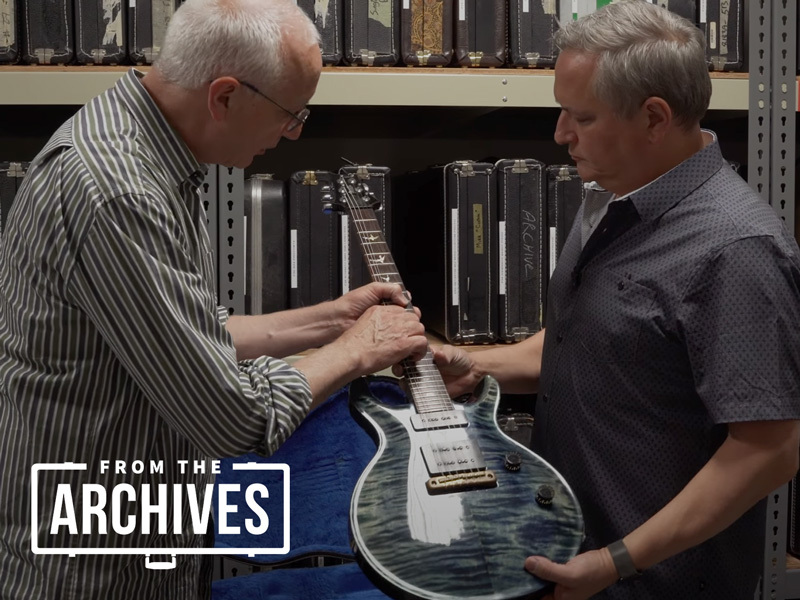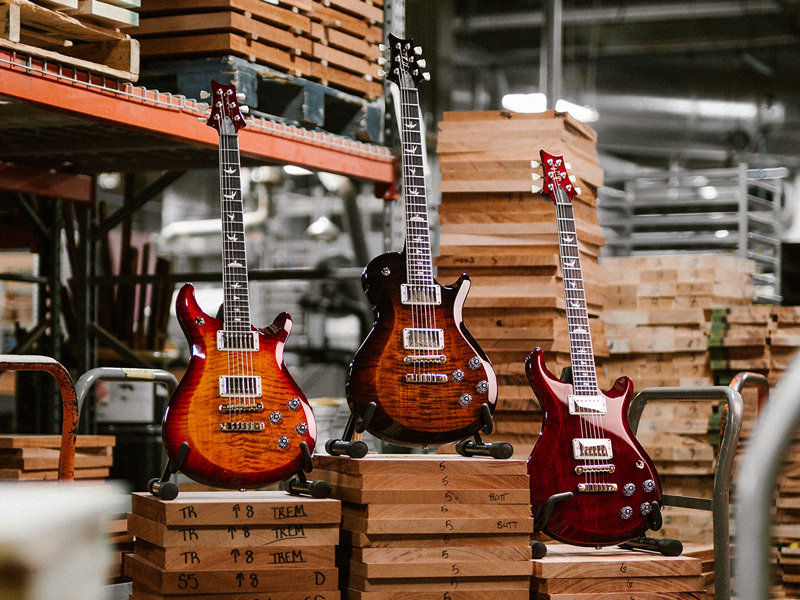OUR MISSION STATEMENT
Guitar building is an ongoing process of discovery. We are devoted to the guitar's rich heritage while committed to new technologies that will enrich our products with uncompromised tone, playability and beauty. Our success depends on our ability to listen, implement positive change and continually refine our craft.
Believing this, we strive to build the best guitars and guitar products possible and to serve our employees, customers, suppliers and community with distinction.
The PRS Story
by Paul Reed Smith
The road from my workshop in a historic, haunted Annapolis garret to a state-of-the-art factory was a tough one. Fact is, I always loved working with my hands. Why else would a high school kid sign up for three or four shop classes at a time? My first guitar was built as a challenge to my college music professor for some credits. I got an “A” and decided to pursue my dream of making guitars for a living.
I remember hanging out at the local concert arenas for six or seven hours before a show to make friends with the roadies. With a backstage pass in hand, I’d peddle my guitars to the stars. One night in ten I’d make a sale. Carlos Santana, Al Di Meola, Howard Leese, and other well-known players agreed to check one out. I made deals. If someone gave me an order, made a deposit, and then didn’t love the finished guitar, I’d give them their deposit back even if I couldn’t make my rent the next day.
After getting a small following and orders for more than 50 guitars, we built two prototypes. I popped them in the back seat of my truck and called on guitar dealers up and down the East Coast. After many days and many miles, I came back with enough orders to start a company.
We’ve come a long way, with steady growth in factory capacity, employees, distribution, and the number of prominent artists using our instruments. We’re not stopping here. Every inch of your PRS guitar is based on decades of testing, rethinking, and reinventing. We continue to push the curve beyond what others would consider perfection. With experts to make sure the technology is unsurpassed, and dedicated craftspeople who guarantee a finished product you can’t put down. We make no compromises. That’s the story of the beginning of the journey. Not so short, but very sweet. The moral? Believe in your dreams.
- Paul Reed Smith, 1992
Historic Timeline
From the foundation of our business to early patents and current innovations, explore a historic timeline of monumental moments in our company history below.
1976

Paul Reed Smith builds his first guitar
Paul Reed Smith made his first guitar as an extra credit project while studying at St. Mary's College in Maryland. He got an "A" and that’s when Smith decided to follow his dream and make guitars for a living.
1981

Compensated Nut Awarded
To address the age-old problem of fretted instruments not playing in tune at the nut-end of the neck, Paul Reed Smith invented a compensated nut to improve intonation throughout the fretboard.
1984

Tremolo Patent Awarded
After Carlos Santana requested a guitar with a vibrato that stayed in tune, Paul Reed Smith began his quest of creating the currently patented PRS tremolo system with the help of John Mann.
1984

First Orders
In 1984, Paul set out on a tour of East Coast guitar dealers armed with two prototypes (pictured). Sam Ash placed the first order with Paul for 30 guitars on this trip, bringing value to the company that would later help secure official investors.
1985

Open for Business
After attending his first winter NAMM show in January of 1985 with a small selection of guitars, Smith returned to Annapolis, Maryland and moved into the PRS Virginia Ave factory. For four months, a small team of fewer than 15 employees began building 20 un-serialized guitars.
1986

1000th Guitar Made
The very first production serial-numbered instrument came off the line in August 1985. On June 27th, 1986 PRS celebrated "The Night of the 1,000 Guitar Party." PRS Guitars was gaining momentum.
1992

Double-Action Truss Rod
In 1992 the truss rod in a PRS neck was changed from a single-action to a double-action style. With the ability to correct both bowed and flexed necks, the double-action truss rod not only allowed for increased adjustability, it also helped create an even more stable neck.
1992

Dragon 1
When Paul Smith was 16, he dreamt about a guitar with a dragon inlaid down the neck. 20 years later, the first PRS Dragon guitar was born. With a list price of $8,000 it was an ultra-high-end "collector" guitar.
1993/4

A Step into the Vintage Market
In 1993 and 1994, PRS introduced the Custom 22 and McCarty Models (respectively). Paul believed that the shorter neck provided a fatter, more vintage tone, and with the McCarty model he was paying tribute to his teacher, Ted McCarty, a master of the vintage market.
1996

Move to Kent Island
After outgrowing the original Virginia Avenue shop, PRS Guitars moved to a new building across the Chesapeake Bay on Kent Island. With 20,000 square feet of space, the new facility provided a more mature manufacturing space and workflow for PRS’s growing family of luthiers.
1996

PRS Private Stock Introduced
Based off of the 1995 "Guitars of the Month" program, Paul Smith, Joe Knaggs, and a small team of talented luthiers began building custom guitars for musicians under the Private Stock program. The Private Stock team remains small and highly talented, constantly striving to create the best guitars money can buy.
1996

PRS Guitar Added to Smithsonian Collection – Washington DC
When the Smithsonian National Museum of American History in Washington DC assembled more than a dozen guitars to exemplify the role of the instrument in American popular music, a PRS Dragon I was proudly included in the exhibit. This marks the first of many PRS guitars to be displayed in museums across the nation, including a small collection of PRS instruments in The Metropolitan Museum of Art’s permanent collection in New York.
1996

PRS Hits 100 Employees
As PRS grew in the late 90's, PRS hired its 100th employee. Today, PRS’s headcount hovers around 355 employees, covering a broad spectrum of important roles, including production, R&D, sales, marketing, artist relations, customer service, supply chain, and more.
1997

PRS McCarty on HRC Baltimore, MD
In 1997, a 65-foot tall PRS McCarty model was placed atop the Hard Rock Cafe in Baltimore Maryland’s Inner Harbor.
2000

Piezo Patent Granted
PRS Guitars introduced the first piezo equipped guitar in 1998. After customizing the system with LR Baggs, the design was granted a US patent in 1999. The LR Baggs / PRS Piezo system provides musicians with both beautiful acoustic guitar tones and electric guitar tones in one instrument.
2000

PRS Awarded MIPA for Singlecut Model
In 2000, PRS received its first Musikmesse International Press Awards (mipa) for “Best Electric Guitar.” Press from all over the world vote for this distinguished honor each year and winners are announced at the Musikmesse / Prolight + Sound trade show in Frankfurt, Germany. As of 2019, PRS has received the “Best Electric Guitar of the Year” accolade nine times.
2001

PRS SE Series Introduced
The SE line began in 2001, made with the goal of providing an affordable instrument with the high-quality and dependability players love from PRS. Carlos Santana played a large role in bringing the project online and the Santana SE was the first model to be introduced.
2005

PRS Wins Lawsuit – Singlecut Returns to the Line
In September 2005, the Sixth Circuit Court of Appeals reversed a lower court decision, ordering the dismissal of Gibson’s suit against PRS. After appeal, the United States Supreme Court decision ended Gibson's multi-year effort to thwart legitimate competition under the guise of intellectual property law. PRS immediately resumed production of the PRS Singlecut.
2007

First PRS Experience Event Held at PRS HQ
With the goal of celebrating the company and showing appreciation for the thousands of PRS fans and players around the world, PRS held its first free public multi-day “Experience” event consisting of factory tours, guitar demos, and live music performances.
2008

Stevensville, MD Expansion Opens
As PRS sales and production grew, additional factory space and equipment was needed yet again in order to keep up with demand. Groundbreaking began in 2006 and in 2008 phase two of PRS Guitars' Stevensville factory was completed. The new building added 90,000 sq feet of much-needed production and office space.
2009

Acoustics and Amplifiers and a Tech Center – Oh My!
In 2009, PRS Guitars introduced several new ventures, including: PRS acoustics, PRS amplifiers, and the PRS Tech Center (PTC). The PRS acoustic introduction brought the PRS Angelus Cutaway and Tonare Grand instruments to the world. PRS Amplifiers brought all-tube designs to players thanks to a close collaboration with Texas amp designer Doug Sewell. And the PTC opened for business as the only authorized PRS service and repair center.
2010

Paul Reed Smith Awarded Vintage Guitar Innovator Hall of Fame Award
Paul Reed Smith was inducted into Vintage Guitar Magazine’s prestigious Hall of Fame, joining past inductees Leo Fender, Les Paul, and Ted McCarty. Vintage Guitar publisher Alan Greenwood noted, “Paul is the first of his generation of guitar builders to be inducted to the Vintage Guitar Hall of Fame, his entry marks a changing of the guard.”
2012

PRS SE Acoustics Introduction
Three years after introducing acoustics, PRS unveiled the first SE Series acoustic guitars in 2012. Now a major part of the PRS SE Series, these acoustics share many appointments from the Private Stock designs, including PRS’s signature bracing pattern and body shapes.
2013

PRS Introduces PRS S2 Series
After a lengthy R&D process, the S2 Series was introduced in 2013 and aimed to fill the gap between PRS’ affordable line of SE instruments and the renowned US core line. The American-made line of guitars has grown from three instruments to more than a dozen and caters to a new breed of player.
2017

PRS Introduces McCarty 594 – Another Foray into the Vintage Market
The McCarty 594 was introduced with the goal of offering a vintage-sounding instrument with the reliability of modern-day manufacturing. For the first time in production, the 594 offered a 3-way toggle on the upper bout of the double-cutaway PRS body shape, a 24.594” scale length, and introduced 58/15 LT pickups.
2017

PRS Brings Back the CE 24 – Bolt-On Favorite
The PRS CE was first introduced in 1988 as PRS’s first bolt-on guitar offering. In 2017, the CE returned after nearly a decade out of the lineup and paved the way for a more significant bolt-on model offering from PRS.
2018

PRS Silver Sky Makes Waves with Single Coils
After years of development and collaboration with John Mayer, PRS introduced the Silver Sky, a three single-coil guitar inspired by Mayer and Smith’s favorite 1963 and 1964 instruments. The launch created waves in the guitar community and traffic unexpectedly crashed the PRS website for a brief period on launch day.
2018

TCI Pickups Begin
“TCI,” meaning Tuned Capacitance and Inductance, was a technology revelation discovered in the research and design phase of the Silver Sky’s 635JM pickups. More than a pickup, TCI is a process that allows pickups to be fine-tuned to sound exactly as desired. As part of the 35th Anniversary celebration, PRS house-wound pickups have all been tweaked with TCI.
2018

PRS Introduces From the Archives Series
PRS Guitars’ collection of archive guitars boasts more than 100 instruments and parts – from the guitars Paul used to get our first orders to prototypes of more recent models. This original series of videos sees Paul Reed Smith and long-time employee Marc Quigley opening archive guitar cases and telling stories From the Archives. With more than 40 million views, the PRS Guitars YouTube channel is updated frequently with videos for guitar players and enthusiasts. From original content series and factory tours to product demonstrations and guitar tips to live premier events, there’s hours of entertainment to enjoy.
2019

PRS Dedicated SE Factory Opens
2019 saw the opening of a dedicated facility in Surabaya, Indonesia where employees give 100% focus to building SE Series instruments to PRS’s exacting specifications. PRS would quickly outgrow this factory, opening another, new dedicated facility with more capacity in 2022.
2019

PRS Introduces Proprietary Strings
The PRS Pulse PRS’s Maryland electric guitar production switched over to a new proprietary lineup of Signature Series strings, complementing the existing classic series strings which were used on PRS Guitars for more than 30 years. Signature Series strings feature a reformulated alloy for louder and brighter tone as well as soldered ends for extended string life and durability.
2020

PRS Brings McCarty Family to the S2 Series
Ted McCarty was a mentor and friend to Paul Reed Smith and PRS Guitars. Through the years, PRS has paid tribute to McCarty by giving his name to its vintage-inspired instruments. In 2020, several McCarty models made it to the S2 Series for the first time, signifying not just new models, but a new vein for PRS S2.
2021

PRS Hits 400 Employees
As demand for PRS Guitars grew, new employees were brought on and trained up. In 2021, the overall headcount rose to more than 400 employees for the first time. Previously, the 100-employee mark was passed in 1997.
2022

PRS SE Acoustics Get a Proprietary Voice
EQ’d in Paul Reed Smith’s home studio and implemented by Larry Fishman and his engineering team, the PRS-Voiced Fishman Sonitone Pickup was specially voiced to allow the natural sound of PRS’s body shapes and bracing design to come through. This proprietary sound brings PRS DNA further into the acoustic market.
PRS Factory Tours
Visit our Stevensville, MD headquarters for a firsthand look at our processes, instruments, and amplifiers from raw wood or blank chassis form to finished guitar or amplifier. What we hope you leave with is a unique view into not just our work but the people building PRS. The craftspeople here are a unique bunch. We have a passion for building instruments and also for the music that these instruments help create.
As our guest, you will see our guitar manufacturing line, our SE Series inspection team, and our amplifier department.
